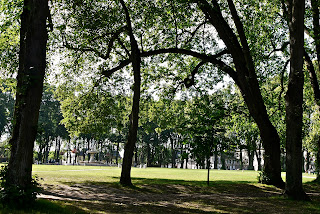Bayeux Cathedral
We are staying in Bayeux and, after a morning seeing the chateau of Balleroy and the abbaye of Cerisy-la-Foret, it was time to do a city walk. We had picked up a leaflet describing a circuit around old Bayeux and we joined it at a fairly random point in the north east of the city centre. Our first landmark was the remnants of the former ramparts, now a car park. The house on the right contains one of the towers which was once part of the city walls.
We emerged into rue St Malo to admire the first of a number of fine old timber-framed houses. The statues attached to the facade were especially pleasing.
Then right into rue Franche, with some fine old houses, notably this one: a many sided tower with a square room at the top.
We then looped down to the side of the cathedral and up rue des Cuisiniers to see this magnificent multi-storey house on the corner.
Now right into rue Saint-Martin and across the river Aure. A short detour beside the river reveals this pretty water mill.
Further along the pedestrianised street, thronged with restaurants, we turned right and then through an archway to reach the former seminary which now houses the world-famous Bayeux tapestry.
We went to see the tapestry on our first afternoon in Bayeux and it is truly amazing. Such vibrant images, whose use of colour goes a long way to overcome the limitations of the lack of perspective (not documented until Alberti's On painting in 1435). The audio guide provides an invaluable, if rather brisk, account of the story it tells and highlights some nice details: the spy behind the pillar and the laughing horses on the Norman invasion fleet. It was so good that we went back to the beginning and looked at the 70m tapestry again. Here is just a small taste (the charge of the Norman cavalry at the Battle of Hastings):
For those of us whose main experience of tapestry is of the wall-sized Aubusson tapestries you find in seemingly every chateau you visit in France, the surprising thing about the Bayeux Tapestry is how small it is: only about 19" high. The other surprising discovery is that although commissioned by William the Conqueror's brother Odo (who is seen swinging his mace in some scenes - he was a prelate and so not allowed to shed blood), the tapestry seems to have been made by English craftsmen.
Turning right into rue de Nesmond you soon reach the cathedral (see the photo at the head of this post). It makes a dramatic first impression with its mass, flying buttresses and three towers. The central tower is capped with a green domed "bonnet". The tower dates from the 15th century, but the bonnet was added only in the 19th. My aged Michelin guide describes it as being in "a most unfortunate style". I wonder what Pevsner would have said!
Around the side, the south transept has the story of Thomas a Becket in the tympanum.
The Cathedral dates from 1077, but what you see now is a harmonious mixture of Norman romanesque and later Gothic. We found the romanesque arcade of the nave especially fine.
The oldest unaltered part of the Cathedral is the atmospheric crypt with lovely 15th century reddish-coloured frescoes of angels playing musical instruments.
To complete our circuit, we walked up to Place Charles de Gaulle. Bayeux was one of the first places to be liberated in 1944 and General de Gaulle made famous speech here at the time: “In our glorious, mutilated Normandy, Bayeux and its environs were witnesses to one of the greatest events in History”.
Distance: no more than three miles.
Conditions: a threat of rain, but generally sunny..
Rating: four stars (five if you include the tapestry as well).












No comments:
Post a Comment